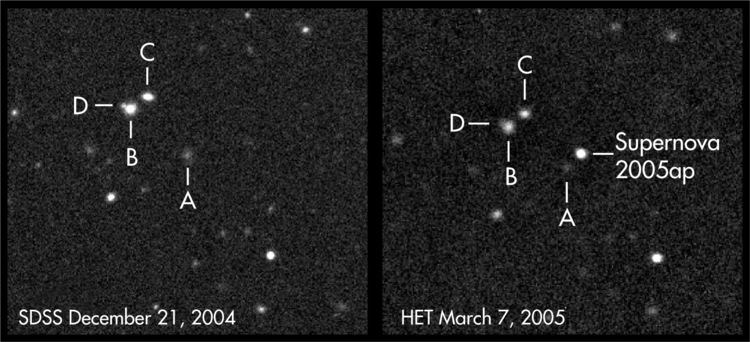Other designations SN 2005ap Spectral class Ic Declination +27° 43′ 31.4″ | Event type Supernova Right ascension 13 01 14.84 | |
 | ||
Date by Robert QuimbyTexas Supernova Search Similar SN 2006gy, SN 2007bi, NGC 1260, GRB 080319B, SN 2003fg | ||
SN 2005ap was an extremely energetic type Ic supernova in the galaxy SDSS J130115.12+274327.5. With a peak absolute magnitude of around −22.7, it is the brightest supernova yet recorded, twice as bright as the previous record holder, SN 2006gy. It was initially classified as type II-L, but later revised to type Ic. It was discovered on 3 March 2005 on unfiltered optical images taken with the 0.45 m ROTSE-IIIb (Robotic Optical Transient Search Experiment) telescope, which is located at the McDonald observatory in West Texas, by Robert Quimby as part of the Texas Supernova Search that also discovered SN 2006gy. Although it was discovered before SN 2006gy it was not recognised as being brighter until October 2007. As it occurred 4.7 billion light years from Earth it was not visible to the naked eye.
Although SN 2005ap was twice as bright at its peak than SN 2006gy it was not as energetic overall as the former brightened and dimmed in a typical period of a few days whereas the latter remained very bright for many months. SN 2005ap was about 300 times brighter than normal for a type II supernova. It has been speculated that this supernova involved the formation of a quark star. Quimby has suggested that the supernova is of a new type distinct from the standard type II supernova and his research group have identified five other supernovae similar to SN 2005ap and SCP 06F6, all of which were extremely bright and lacking in hydrogen.
